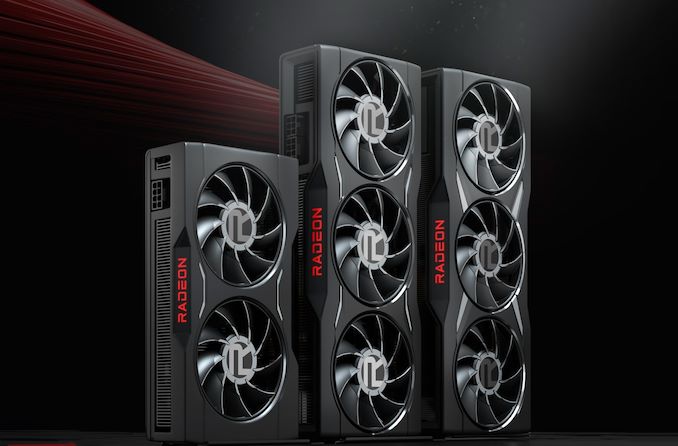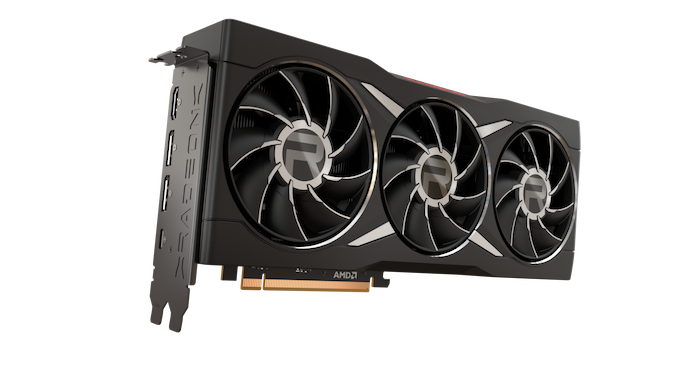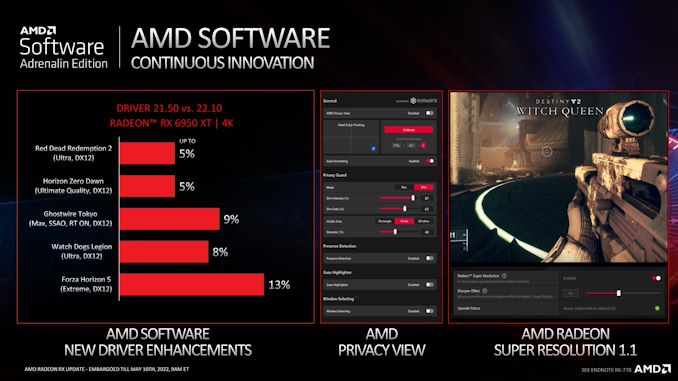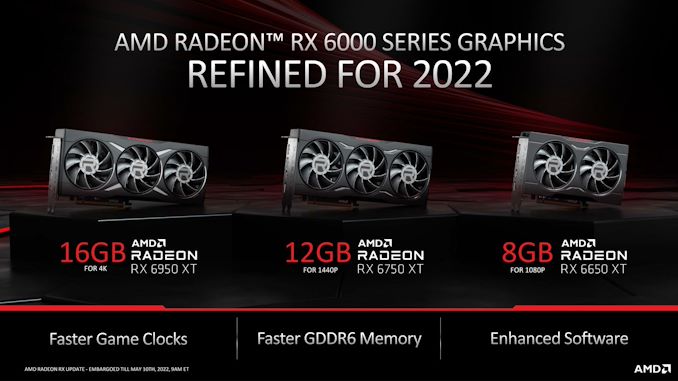AMD Releases Radeon RX 6950 XT, 6750 XT, and 6650 XT: A Bit More Speed For Spring
by Ryan Smith on May 10, 2022 9:00 AM EST
AMD this morning is taking the wraps off a trio of new Radeon RX 6000 series video cards to round out its product stack. Aimed at everything from the midrange to flagship markets, the new Radeon RX 6950 XT, RX 6750 XT, and RX 6650 XT are being released as a mid-generation kicker to the Radeon family, to give AMD’s most important cards one last boost in performance. Taking advantage of newer 18Gbps GDDR6 memory along with slightly improved clockspeeds, the new cards, being released today, promise modest performance gains while giving AMD a chance to show off what their RDNA2 GPU architecture can do after nearly 18 months of refinement.
At a high level, these three new cards are all small updates to AMD’s existing Radeon RX 6900 XT, RX 6700 XT, and RX 6600 XT parts. Aiming to take advantage of the increasing availability of 18Gbps GDDR6, AMD has opted to equip it to three of the most important cards in the RX 6000 family in order to provide them with a moderate boost in memory bandwidth. At the same time, AMD is also using this opportunity to turn up the heat – both figuratively and literally – increasing the cards’ TDPs a bit to allow for slightly higher GPU clockspeeds.
The overall change, as noted before, is minor, both in terms of performance and card construction. With the exception of the swap to 18Gbps GDDR6 memory, these updated specifications are attainable by current card designs, and there are no other hardware changes. Meanwhile AMD’s own estimates for the performance improvement from the new cards is on the order of 5% to 6% – the memory bandwidth increase being tempered by the smaller increase in GPU clockspeeds.
Still, for AMD it’s an opportunity to improve their competitive positioning of some of their most significant video cards by that much more; to pull ahead of NVIDIA in the final six months or so of the current generation of video cards. NVIDIA has long since shown their hand with their own mid-generation kicker parts like the 3080Ti/3070TI and 3080 12GB, so AMD gets the advantage of making what’s presumably going to be the last move here (at least in the upper echelons of performance).
Updated Radeon RX 6000 Product Stack: Expansion and Retirement
The timing of all of this does have AMD inadvertently trying to catch a falling knife, however, as after 18 months of frustration, normalcy is finally returning to the video card market. Retail video card prices are approaching their original MSRPs, as cryptocurrency mining profitability has plummeted and supply situations have improved. Which is fantastic news for gamers, computer scientists, and anyone else wanting a video card at a (more) reasonable price, but is a little more problematic for AMD in trying to price and position their new parts. AMD has already needed to reprice their new cards once before they even launched, and now these cards, which were designed to be a premium, higher-priced offering, are going to be facing a lot more market pressure.
Along with adding the RX 6950 XT, RX 6750 XT, and RX 6650 XT to AMD’s sizable Radeon RX 6000 series product stack, AMD is also using this opportunity to retire a video card: the Radeon RX 6600 XT. What was originally the fastest of the Navi 23 cards, and the cornerstone of AMD’s midrange video card efforts, is eventually going to be no more. That card’s position in the market is being replaced wholesale by the fastest RX 6650 XT.
| AMD Radeon RX 6000 Series Product Stack | |||
| Lowest Retail Price | |||
| RX 6950 XT | $1099 | ||
| RX 6900 XT | $949 | ||
| RX 6800 XT | $849 | ||
| RX 6800 | $759 | ||
| RX 6750 XT | $549 | ||
| RX 6700 XT | $484 | ||
| RX 6650 XT | $399 | ||
| $369 | |||
| RX 6600 | $335 | ||
| RX 6500 XT | $199 | ||
| RX 6400 | $159 | ||
Past that, the RX 6900 XT and RX 6700 XT are set to remain in production. Though with the cheapest 6900XT already hitting $950, AMD and its partners may quickly find themselves in a situation where they’re going to have to let their new cards float down in price as well alongside the rest of the product stack.
As an aside, I’m glad to see AMD use a sensible naming system with these new parts. Giving all of the new cards an xx50 designation makes it easy to tell both that they’re meaningfully different from the existing cards, and to tell where they slot in within the larger product stack. AMD has 4 digits, and it’s good to see that AMD is using at least 3 of them, rather than adding more suffixes or overloading product names entirely with multiple variations.
Radeon RX 6950 XT, RX 6750 XT, and RX 6650 XT
Diving into the specs, let’s start looking at the new cards.
| AMD Radeon RX 6800/6900 Series Specification Comparison | ||||||
| AMD Radeon RX 6950 XT | AMD Radeon RX 6900 XT | AMD Radeon RX 6800 XT | AMD Radeon RX 6800 | |||
| Stream Processors | 5120 (80 CUs) |
5120 (80 CUs) |
4608 (72 CUs) |
3840 (60 CUs) |
||
| ROPs | 128 | 128 | 128 | 96 | ||
| Game Clock | 2100MHz | 2015MHz | 2015MHz | 1815MHz | ||
| Boost Clock | 2310MHz | 2250MHz | 2250MHz | 2105MHz | ||
| Throughput (FP32) | 21.5 TFLOPS | 20.6 TFLOPS | 18.6 TFLOPS | 13.9 TFLOPS | ||
| Memory Clock | 18 Gbps GDDR6 | 16 Gbps GDDR6 | 16 Gbps GDDR6 | 16 Gbps GDDR6 | ||
| Memory Bus Width | 256-bit | 256-bit | 256-bit | 256-bit | ||
| VRAM | 16GB | 16GB | 16GB | 16GB | ||
| Infinity Cache | 128MB | 128MB | 128MB | 128MB | ||
| Total Board Power | 335W | 300W | 300W | 250W | ||
| Manufacturing Process | TSMC 7nm | TSMC 7nm | TSMC 7nm | TSMC 7nm | ||
| Transistor Count | 26.8B | 26.8B | 26.8B | 26.8B | ||
| Architecture | RDNA2 | RDNA2 | RDNA2 | RDNA2 | ||
| GPU | Navi 21 | Navi 21 | Navi 21 | Navi 21 | ||
| Launch Date | 05/10/2022 | 12/08/2020 | 11/18/2020 | 11/18/2020 | ||
| Launch Price | $1099 | $999 | $649 | $579 | ||
Starting at the top, we have AMD’s new flagship, the Radeon RX 6950 XT. A souped-up version of the original RX 6900 XT, this is now the most powerful card within AMD’s product stack – and the most expensive.
Seeing as how the original RX 6900 XT was already based on a fully-enabled Navi 21 GPU with 40 CUs and 128MB of Infinity Cache, AMD has few avenues to boost performance here besides cracking up GPU and memory clockspeeds, so that’s exactly what they’ve done. Along with pairing the card with 16GB of the latest 18Gbps GDDR6 memory, the card’s GPU clockspeeds have been boosted; the official game clock is now 2100MHz (+10%), and the maximum boost clock is 2310MHz (+3%). This gives the RX 6950 XT 12.5% more memory bandwidth, and on average several percent faster throughput throughout the GPU itself.
In order to pay the bill for this improved performance, AMD has also cranked up the TBP. Whereas the original RX 6900 XT was a 300W card, the RX 6950 XT is a 335W card at reference specifications, and board partners can always crank that up further. AMD at this point is playing at the far end of the voltage/frequency curve for their parts, and while raising the TBP does allow for improved performance by allowing the card to get closer to its max GPU clockspeed more often, they are well into diminishing returns at this point. All of which is further reflected in AMD’s official performance figures, which have the RX 6950 XT landing at about 4% faster than the original RX 6900.
On that note, it’s worth pointing out that the new 18Gbps GDDR6 may also be playing a factor in the TBP increases for these new cards. While the voltage for the latest GDDR6 remains at 1.35v, overall power consumption can still be on the rise due to the power costs of supporting such high signaling rates. AMD doesn’t formally break out the power usage of its cards by GPU and DRAM, but I would not be the least bit surprised if, all other things held equal, DRAM power consumption is higher on the RX 6950 XT than it was the RX 6900 XT. At which point, if AMD was going to need to increase TBPs anyhow (to keep clockspeeds constant), why not increase them a bit more to wring out some extra headroom from the GPU itself.
| AMD Radeon RX 6700/6600 Series Specification Comparison | ||||||
| AMD Radeon RX 6750 XT | AMD Radeon RX 6700 XT | AMD Radeon RX 6650 XT | AMD Radeon RX 6600 XT | |||
| Stream Processors | 2560 (40 CUs) |
2560 (40 CUs) |
2048 (32 CUs) |
2048 (32 CUs) |
||
| ROPs | 64 | 64 | 64 | 64 | ||
| Game Clock | 2495MHz | 2424MHz | 2410MHz | 2359MHz | ||
| Boost Clock | 2600MHz | 2581MHz | 2635MHz | 2589MHz | ||
| Throughput (FP32) | 12.8 TFLOPS | 12.4 TFLOPS | 9.9 TFLOPS | 9.7 TFLOPS | ||
| Memory Clock | 18 Gbps GDDR6 | 16 Gbps GDDR6 | 18 Gbps GDDR6 | 16 Gbps GDDR6 | ||
| Memory Bus Width | 192-bit | 192-bit | 128-bit | 128-bit | ||
| VRAM | 12GB | 12GB | 8GB | 8GB | ||
| Infinity Cache | 96MB | 96MB | 32MB | 32MB | ||
| Total Board Power | 250W | 230W | 180W | 160W | ||
| Manufacturing Process | TSMC 7nm | TSMC 7nm | TSMC 7nm | TSMC 7nm | ||
| Transistor Count | 17.2B | 17.2B | 11.06B | 11.06B | ||
| Architecture | RDNA2 | RDNA2 | RDNA2 | RDNA2 | ||
| GPU | Navi 22 | Navi 22 | Navi 23 | Navi 23 | ||
| Launch Date | 05/10/2022 | 03/18/2021 | 05/10/2022 | 08/11/2021 | ||
| Launch Price | $549 | $479 | $399 | $379 | ||
Meanwhile, slotting in towards the middle of AMD’s Radeon product stack, we have the RX 6750 XT and RX 6650 XT. Like the RX 6950 XT, the predecessors to these cards were already based on fully-enabled Navi GPUs – Navi 22 and Navi 23 respectively – so AMD is turning to increasing clockspeeds to improve performance.
For the RX 6750 XT, compared to the original RX 6700 XT the maximum clockspeed has been boosted to 2600MHz (+ <1%), while the game clock is now 2495MHz (+3%). So the expected performance gains coming from the highest GPU clockspeeds are minimal, and the bulk of the lifting will need to come from the 18Gbps GDDR6. But despite this, AMD’s own performance figures show the RX 6750 XT benefitting from these upgrades more than the RX 6950 XT did; AMD’s second-tier card is a bit over 7% faster in their data.
Meanwhile the RX 6650 XT, which is outright replacing the original RX 6600 XT, comes with a maximum clockspeed of 2635MHz and a game clock of 2410MHz, both of which are around 2% faster than the original card. And, despite an increase in TBP and 12.5% more memory bandwidth, it shows the smallest gains in AMD’s official figures, with just a 2% performance uplift. In this context it’s understandable why AMD is not keeping the original RX 6600 XT around, as the RX 6650 XT is not fast enough to meaningfully separate itself from the old card.
We’ll see how third-party benchmarks play out once these cards start shipping, but assuming AMD’s data is accurate here, it’s a testament to the value of their on-die Infinity Cache. While memory bandwidth increases almost never play out as 1-to-1 performance increases, it’s remarkable how little performance is being added by the extra bandwidth – or conversely, how well the Navi 23 GPU was already being fed by 16Gbps GDDR6 on just a 128-bit memory bus. Even just 32MB of cache is doing a whole lot of work to limit DRAM bandwidth needs at 1080p.
Finally, like the RX 6950 XT, TBPs for these two cards are increasing as well. The RX 6750 XT will carry a 250W reference TBP, which is 20W higher than the original RX 6700 XT. Meanwhile the RX 6650 XT will be tuned for 180W, which is also 20W higher than its predecessor, the RX 6600 XT.
Driver News: Privacy View & AMD Super Resolution 1.1
Tucked into today’s product announcement is also a short update on the driver side of AMD’s product ecosystem.
AMD’s GPU-accelerated Privacy View feature, which was originally slated to launch in Q1, is finally nearing release and should be in this month’s driver drop. Meanwhile, according to AMD an updated version of their driver-based AMD Super Resolution technology is in the works. Though at this point they’re not disclosing what features will be tweaked or added for what will be Super Resolution 1.1.
Partner Cards & Product Positioning
Given that today’s launch is a relatively minor update to a few of AMD’s existing cards, AMD and its board partners are hitting the ground running with the new cards. Along with their partners’ own work, AMD is releasing updated versions of their reference cards for the RX 6950 XT and RX 6750 XT. So gamers who preferred AMD’s reference designs – or even just buying directly from AMD – will be able to do so.
Meanwhile the board partners will, as always, be doing their own thing. Expect to see the usual mix of stock-clocked and factory overclocked cards, with the board partners looking to squeeze just a bit more out of AMD’s latest hardware.
Beyond information about today’s launch, AMD hasn’t given us much information about availability. But given how long the underlying GPUs have been in production – and how readily available the 6900XT/6700XT/6600XT have been in recent weeks – this should not be an especially frantic or supply-constrained launch. All of which is a nice change in pace after the previous 18 months.
Though it remains to be seen just how much of a stomach the overall video card market has for new premium-priced Radeon cards right when the original cards are finally falling to more reasonable prices. As supplies for anything that isn’t an RX 6800 or RX 6600 is largely unconstrained at this point, most of the value in the new cards comes from their marginally higher performance, which means the ecosystem doesn’t have much leeway to give for higher prices. Perhaps it shouldn’t be too surprising then that AMD is already ramping up further measures to shore up video card prices, including an impending game bundle offer, which is kicking off today despite not actually being live yet.
Thankfully for AMD, their competition isn’t themselves, but rather it’s market leader NVIDIA. And while prices on GeForce cards have come down as well, the more mining-friendly cards have been slower to come down, leaving many of them still selling a decent bit above their original MSRPs. So with a sizable and now even larger product stack to work with, AMD has a counterpart to everything within NVIDIA’s stack – and for now, an often-significant significant price advantage.
AMD reckons they have the performance advantage as well, and while I have significant doubts we’ll see the RX 6950 XT consistently outperform the RTX 3090 (AMD’s chosen competition), the RX 6750 XT and RX 6650 XT stand to fare better against NVIDIA’s baseline RTX 3070 and 3060 cards respectively. Which to bring things full circle, is one of the points of this launch: for AMD to put their best foot forward and provide new hardware fodder to showcase where they stand versus NVIDIA.
Wrapping things up, expect to see the new Radeon cards on retail shelves this morning – if not sooner.
| Q2 2022 GPU Product Lineups (Theoretical MSRPs, Please See eBay For Street Pricing) |
|||||
| AMD | Price | NVIDIA | |||
| $1999 | GeForce RTX 3090 Ti | ||||
| $1499 | GeForce RTX 3090 | ||||
| $1199 | GeForce RTX 3080 Ti | ||||
| Radeon RX 6950 XT | $1099 | GeForce RTX 3080 12GB | |||
| Radeon RX 6900 XT | $999 | ||||
| Radeon RX 6800 XT | $649/$699 | GeForce RTX 3080 | |||
| Radeon RX 6800 | $579/$599 | GeForce RTX 3070 Ti | |||
| Radeon RX 6750 XT | $549 | ||||
| Radeon RX 6700 XT | $479/$499 | GeForce RTX 3070 | |||
| Radeon RX 6650 XT | $399 | GeForce RTX 3060 Ti | |||
| Radeon RX 6600 | $329 | GeForce RTX 3060 | |||
| $249 | GeForce RTX 3050 | ||||
| Radeon RX 6500 XT | $199 | ||||
| Radeon RX 6400 | $159 | ||||





















33 Comments
View All Comments
Mike Bruzzone - Sunday, May 15, 2022 - link
I made the pitch to AMD to price Rx 6x50_ at run end 7 nm depreciated node cards add fast memory system too drag down existing N6x inventoried pricing: last in first out. But AMD chose the traditional sales tactic to heap these cards on top of existing inventoried to press older N6x out of inventories; first in first out. Idea of back generation depreciated lithography node wide bus with fast memory will happen again because it's a good idea simply attempted to close on approaching next generation. Depreciated lithography 7 nm and even 12 nm for the industrial embedded market optimized (fast optimized) subsystem design are here to stay this just was not the right timing for the idea. mbvefivivi - Tuesday, May 17, 2022 - link
I can't keep my cool when it comes to video cards. the situation in the market is very sad.Hrel - Monday, September 26, 2022 - link
If anyone at AMD sees this, I'm waiting for a GPU that costs less than $150. It only needs to handle 1080p. I just want something modern and more energy efficient. RX5600XT levels of performance is plenty. That card is what, 3 years old now?I've never spent more than $160 on a GPU and I never will. With that said my current GPU is almost 10 years old from release and about 8 from purchase. It's still fast enough for everything I play, it's just hot and gets loud in unreal engine 4.
I don't think my price is unfair considering how low my requirements are.
Please guys, give us something viable under $150!